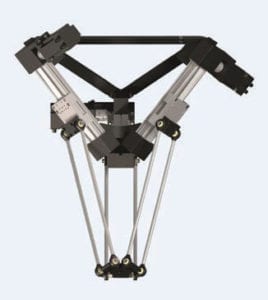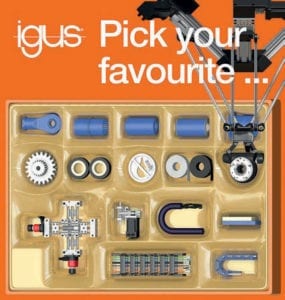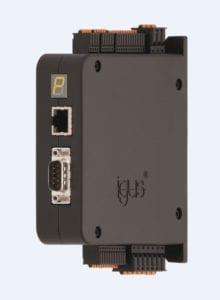TRUST IGUS FOR LOW COST AUTOMATION
Matthew Aldridge, Director, igus uk ltd
Automation at your fingertips: low-priced delta robot from
igus available to build or buy igus introduces fast low-cost robots for less than £5,000
It is well understood within industry that the higher the production rate, the lower the cost per unit will be – making twice as many products as your competitor in the same amount of time is a clear business advantage. Going back in time to the early industrial revolution, the invention of the spinning jenny was one of the key developments in weaving industry – as it held more than one ball of yarn, more yarn was made in a shorter amount of time thereby reducing the overall cost.

Drylin delta robot
Speed remains our industry’s most pressing requirement today and igus continues to develop many low cost automation systems to meet these needs, from linear robots to the robolink robotic arm. Listening to the voice of our customers, we developed our delta robot system for simple assembly tasks, pick and place operations, as well as applications in test & measurement. In 2018, we built a demonstration model for display at a number of exhibitions.
Since then, there has been overwhelming interest from our customers to develop the delta robot as a modular kit and so, we did. Last year, we formed a separate low cost automation business unit. In the UK, this includes Adam Sanjuro as the Delta Robot Product Manager and Angelos Bitivelias as support engineer.
Angelos joined igus as an intern straight from graduating in electro-mechanics at Northampton University. His project was to build a test unit for drylin electrical linear units… he built it and set up the drives and control panel and, in return, I offered him a job!
Low cost automation at your finger tips
 Cost-effective, and quick and easy to implement, the drylin delta robot is available directly from stock as a kit or delivered pre-assembled ready to install. Its maintenance-free belt drive units, lubrication-free link rods, encoders and stepper motors combine to create a lightweight, low-cost automation solution for automated tasks such as pick and place.
Cost-effective, and quick and easy to implement, the drylin delta robot is available directly from stock as a kit or delivered pre-assembled ready to install. Its maintenance-free belt drive units, lubrication-free link rods, encoders and stepper motors combine to create a lightweight, low-cost automation solution for automated tasks such as pick and place.
The lightweight design, consisting of aluminium and engineering plastics, makes the drylin delta robot extremely cost-effective at a price from as little as £5,000 and ensures high speeds. We estimate that with the usual integration
costs, each drylin delta installation will be around £10,000, which means that it will usually pay for itself after a few months – this compares favourably to the industry’s rule-of-thumb target of two years.
The drylin delta robot is based on three maintenance-free drylin ZLW toothed belt axes, lubrication-free igubal link rods and matching adapter plates. NEMA stepper motors and encoders ensure fast handling of up to 1 kg with a precision of ±0.5 mm. The complete system has an installation space of up to 420 mm in diameter and can carry up to 5 kg at lower speeds with a pick rate of at least 60 per minute.

D1 dryve controller
The open design of the drylin delta robot enables manufacturers to use their own controller and preferred software. However, they can opt for the intuitive and easy-to-use dryve D1 controller from igus. There are many other benefits inherent with delta robot deployment; the higher the production rate the lower the cost per unit will be. There are also opportunities to reduce scrap and rework, increase quality and consistency, and improve overall safety.
Depending on requirements, the Delta robot can be delivered as a kit in a box within 24 hours of receipt of order. Comprehensive assembly instructions are included and an assembly video is available online. An experienced engineer should be able to build one in about half an hour. Alternatively, the drylin delta robot can be delivered pre-assembled in a frame ready for installation.
A brief history of delta robots
In 1985, robots that could perform light pick-and-place tasks quickly or repeatedly were few and far between. Professor Reymond Clavel and his team at the Robotics Systems Laboratory at EPFL (École polytechnique fédérale de Lausanne) began the research that would produce the delta robot following a visit to a nearby chocolate factory.
The team was researching repetitive task applications for robots and found that the packing of chocolate pralines into boxes was a good example for this type of high-speed, low payload automation. Dr. Clavel’s idea was to develop a robot that performed three picks per second and, in order to place the pralines correctly, moves with 4 degrees of freedom – along the three axes, as well as rotation on the vertical axis or wrist.
Six months after the visit to the factory, a prototype of the delta robot was made. A type of parallel robot, its design was a complete departure from the robotics arms that usually performed human tasks. Today, delta robots are well established in the automation industry. drylin ZLW

drylin ZLW
drylin ZLW toothed belt axes
- tried and tested at the igus test laboratory
- hard-anodised aluminium drylin W profile guide acts as a linear guide
- polyurethane or neoprene toothed belt acts as drive
- lubrication-free linear guide system with polymer plain bearings made of iglidur J
D1 dryve motor controller
- widely used on single axes, linear, flat and room linear robots
- multifold automation tasks without programming by simple parameterisation
- no software installation or App needed use by PC, tablet or smart phone
- Inputs/outputs, analogue inputs, CANopen, ModbusTCP for connection to master control systems such as Siemens or Beckhoff

